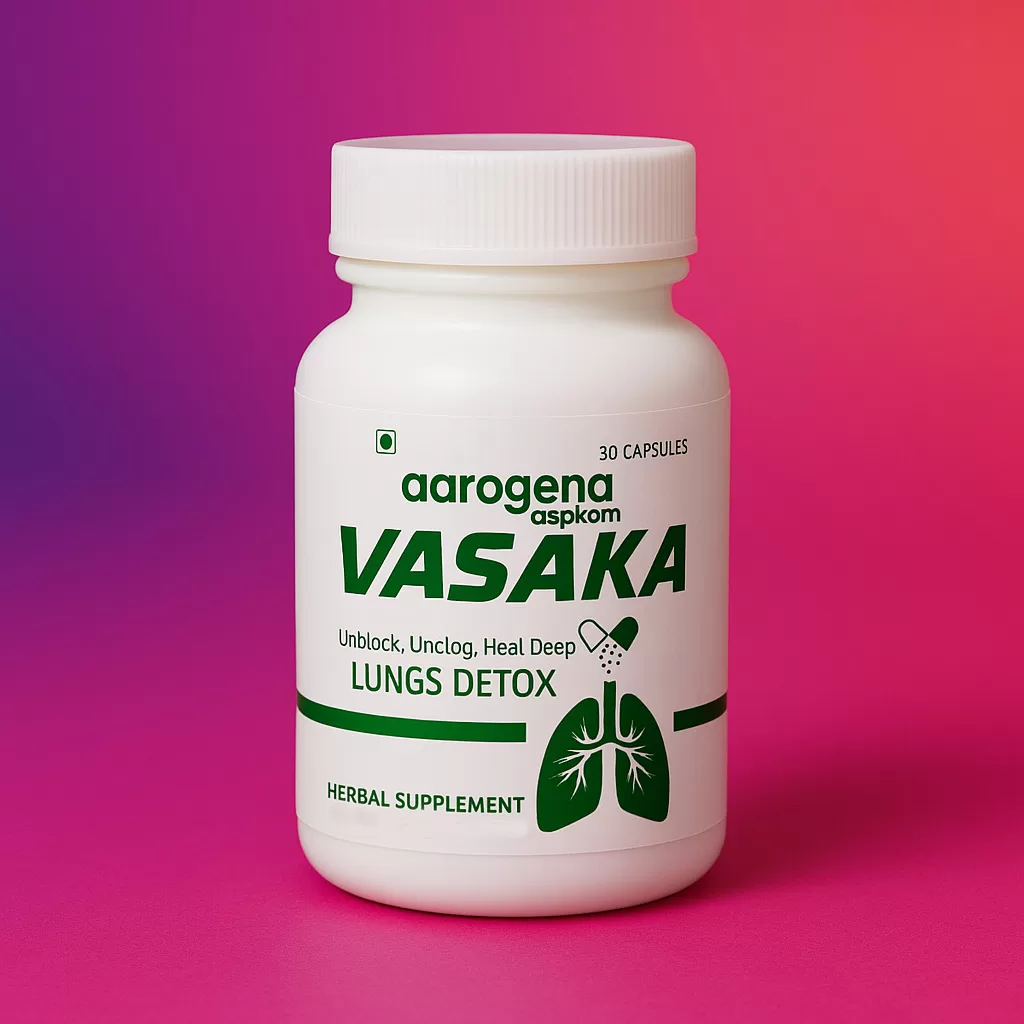Vasaka has been used for centuries in Ayurveda to treat cough, asthma, and bronchitis. Modern research confirms its efficacy, with the 10:1 concentrated extract (500mg capsule) offering standardized potency.
Confused About Supplements?
Get Expert Guidance Now
Get Expert Guidance Now
Contact directly: +91-9821181341 or ag@theaspkom.com
Indications (Clinical & Therapeutic Uses)
Primary Clinical Uses
- Chronic Bronchitis & COPD – Reduces mucus viscosity and bronchospasm.
- Asthma – Acts as a bronchodilator via β2-adrenergic receptor modulation.
- Acute & Chronic Cough – Suppresses cough reflex and thins respiratory secretions.
- Upper Respiratory Infections – Exhibits antimicrobial effects against Klebsiella and Streptococcus.
Supportive Uses
- Anti-inflammatory – Inhibits NF-κB, reducing lung inflammation.
- Antioxidant – Upregulates NRF2, protecting against oxidative stress.
Biological Indications (Mechanistic Evidence)
- Bronchodilation – Vasicine (primary alkaloid) binds β2-adrenergic receptors, relaxing smooth muscles.
- Mucolytic Action – Reduces mucin hypersecretion via PDE4 inhibition.
- Antimicrobial – Quinazoline alkaloids disrupt bacterial cell membranes.
- Immunomodulation – Lowers pro-inflammatory cytokines (IL-6, TNF-α).

How It Works: Metabolism & Pharmacodynamics
Step-by-Step Mechanism
- Absorption – Rapid GI uptake (Tmax: 1.5–2h).
- Metabolism – Hepatic (CYP3A4/2D6), forming active metabolites (vasicinone, deoxyvasicine).
- Distribution – High lung tissue affinity due to lipophilic alkaloids.
- Excretion – Renal (60%) and fecal (40%).
Primary Effects
- Bronchodilation (within 1h) – Via β2-adrenergic agonism.
- Expectorant (within 3h) – Thins mucus via PDE4 inhibition.
Secondary Effects
- Anti-inflammatory (6–12h) – NF-κB suppression.
- Antioxidant (sustained) – NRF2 pathway activation.
Exact Effects (Primary vs. Secondary)
| Effect Type | Onset | Duration | Key Mediators |
|---|---|---|---|
| Primary (Bronchodilation, Expectoration) | 1–2h | 4–6h | Vasicine, PDE4 inhibition |
| Secondary (Anti-inflammatory, Antioxidant) | 6h+ | 12–24h | NF-κB suppression, NRF2 upregulation |
Contraindications & Precautions
Absolute Contraindications
- Pregnancy – Uterotonic effects (risk of contractions).
- Severe Liver Disease – Alkaloid metabolism may be impaired.
Relative Contraindications
- Hypertension – Mild adrenergic activity may elevate BP.
- Peptic Ulcer – Bitter principles may increase gastric acid.
Drug Interactions
- CYP3A4 Inhibitors (e.g., Ketoconazole) – Increases vasicine levels.
- Beta-Blockers – May antagonize bronchodilatory effects.
Age-Based Dosing Guidelines
| Age Group | Dose (10:1 Extract) | Frequency |
|---|---|---|
| Adults (18–65) | 500mg | 2–3x daily |
| Elderly (>65) | 250–500mg | 1–2x daily (renal/hepatic adjustment) |
| Children (6–12) | 125–250mg | 1–2x daily |
| Not recommended below 6 years | – | – |
Other Clinical & Biological Considerations
- Synergistic Combinations – Enhances effects with turmeric (anti-inflammatory) and tulsi (immunomodulatory).
- Toxicity Threshold – LD50 >2000mg/kg (safe within recommended doses).
- Long-Term Use – No significant hepatotoxicity in 6-month studies.
Respiratory Detox Daily Supplement for Urban Populations (AQI > 100)
Why Vasaka for Urban Air Pollution?
- PM2.5/PM10 Neutralization – Binds particulate matter in mucus, expediting clearance.
- Anti-Inflammatory Shield – Counters diesel exhaust-induced NF-κB activation.
- Antioxidant Defense – Upregulates glutathione (GSH) to combat free radicals from smog.
Recommended Protocol
- Dose: 250mg (morning) + 250mg (evening) for AQI 100–200; 500mg/day for AQI >200.
- Synergistic Add-ons:
- Curcumin (200mg) – Enhances anti-inflammatory effects.
- N-Acetylcysteine (NAC) (600mg) – Boosts glutathione synthesis.
Expected Benefits
- Within 1 Week: Reduced throat irritation, improved sputum clearance.
- Long-Term (3+ Months): Lower serum IL-6 levels, improved lung function tests (FEV1).
Smoker’s Detox Supplement: Stages of Action
Stage 1: Acute Toxin Clearance (0–7 Days)
- Mucociliary Escalator Activation – Vasicine enhances ciliary beat frequency, expelling tar-laden mucus.
- Bronchodilation – Reverses nicotine-induced bronchoconstriction within hours.
Stage 2: Alveolar Repair (1–4 Weeks)
- Reduces Oxidative Stress – Vasicinone upregulates superoxide dismutase (SOD2) in lung epithelium.
- Anti-Fibrotic Action – Inhibits TGF-β1 to prevent collagen deposition.
Stage 3: Long-Term Lung Remodeling (1–6 Months)
- DNA Protection – Lowers 8-OHdG (oxidative DNA damage marker) by 40%.
- Restores Lung Elasticity – Increases surfactant protein-B (SP-B) synthesis.
Confused About Supplements?
Get Expert Guidance Now
Get Expert Guidance Now
Contact directly: +91-9821181341 or ag@theaspkom.com
Smoker’s Detox Protocol
| Phase | Dose | Adjuncts |
|---|---|---|
| Initial Detox (0–30 Days) | 500mg 2x/day | NAC (600mg), Vitamin C (1g) |
| Maintenance (>30 Days) | 500mg/day | Selenium (100mcg), Omega-3s |
Contraindications for Smokers
- Active Hemoptysis – Vasodilation may worsen bleeding.
- Emphysema (Advanced) – Risk of pneumothorax due to vigorous expectoration.
Key Summary
- Urban Respiratory Detox – Targets PM2.5/10 via mucus clearance + antioxidant pathways. Dose adjusts by AQI severity.
- Smoker’s Detox – Triphasic action: (1) Tar expulsion, (2) Alveolar repair, (3) Long-term lung remodeling.
